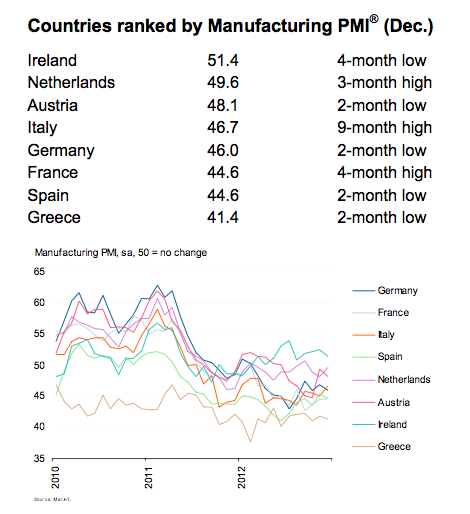It was a global PMI data day yesterday and it started well in Asia. Vietnam showed some weakness but Indonesia , South Korea, Taiwan , India and China all recorded manufacturing expansion in December 2012.
Both the US and the UK also managed a good result but, as usual, it was the Eurozone that disappointed. The US-exposed Ireland managed some gains and a bit of good news from The Netherlands saw it record just on the downside of stable, but that’s where the up-side ended.
Spain, France , Greece and Italy showed further contraction and the possible new entrant, the Czech Republic, looked very poor. But once again the big downside disappointment was Germany which continues to suffer the feedback effects of European austerity.
Output falls at sharper pace during December amid fastest drop in new orders for four months
- New order volumes fall for eighteenth successive month
- Steeper contraction in manufacturing output
- Job shedding continues in December
Business conditions in the German manufacturing sector deteriorated again during December, as highlighted by further declines in both output and new orders. The reduction in overall new work was the sharpest in four months, despite new export orders falling at the least marked pace since March. Lower workloads and fragile confidence regarding the business outlook in turn contributed to a moderate fall in employment numbers during the latest survey period.
…
Manufacturing output fell for the ninth successive month, and at a slightly faster rate than in November. Meanwhile, stocks of finished goods and backlogs of work were reduced further, with the latest decline in post-production inventories the sharpest since February 2010.
German manufacturers reported a sharp reduction in new work during December, which extended the current period of contraction to a year-and-a-half. Anecdotal evidence cited subdued demand from both domestic and export clients. Although new work from abroad declined at the slowest pace since March, latest data pointed to the sharpest overall drop in new orders for four months.
Lower new order volumes contributed to another steep decrease in input buying during the latest survey period. Stocks of purchases also declined, with manufacturers largely commenting on efforts to streamline inventories at their plants. Suppliers’ delivery times meanwhile shortened for the second month running, although the latest improvement in vendor performance was only marginal.
Job losses were reported in the German manufacturing sector for the third month running in December. The rate of decline in staffing levels was modest, but stronger than that registered during November.
And so, although the rest of the world , with a few exceptions, appears to be digging itself out of the funk of 2012 the Eurozone remains deep in manufacturing recession as its policy settings continue to sap internal demand.
- Final Eurozone Manufacturing PMI at 46.1 in December (flash estimate 46.3)
- Downturn remains widespread, with all nations bar Ireland reporting contractions
- Cost caution leads to job losses and further scaling back of inventory holdings

The wrap from Markit’s chief economist sets the tone as we enter the new year.
The eurozone manufacturing sector remained entrenched in a steep downturn at the end of the year. Although not as severe as in the autumn, the survey indicates that production continued to fall at a quarterly rate of approximately 1% in December, therefore acting as a severe drag on the wider economy. The region’s recession therefore looks likely to have deepened, possibly quite significantly, in the final quarter.
“Manufacturers look to be in for another tough year in 2013, though prospects have brightened a little, as producers should benefit from signs of stronger demand in key export markets such as the US and China. Improving competitiveness remains the key to success, however, and Ireland perhaps provides a reassuring example to other countries of how exports can rise on the back of structural reforms.
“Much of course also depends on how the region’s debt crisis evolves over coming months, and any set-backs could mean the resulting damage to domestic business and consumer confidence could easily offset any gains made in export markets outside of the eurozone.”
So, as in 2012, the Eurozone sets itself up for further internal retrenchment in hope that the rest of the world will pull it out of the hole it has, and continues to, dig for itself. Can it happen? I can’t see it. As I’ve explained before a trade surplus requires a corresponding trade deficit. The hope that the massive economies of France , Spain and Italy will be able to find external demand of the magnitude required to offset their own internal economic retrenchment, let alone that of many of their existing trading partners, all at the same time is a work of dangerous economic fantasy. This latest data is simply yet more evidence of that delusion.
As I stated throughout last month I think the markets are severely mis-pricing the risk stemming from the Eurozone over 2013. Although other areas of the globe are showing signs of real economic improvement that do justify recent market gains the same is not true for much of the eurozone. Although recent rallies, such as the one overnight, hide these facts the risk of a European market correction remains high in my opinion because the underlying data simply doesn’t support the idea that the economies of these nations are improving.
Full Eurozone PMI report below: